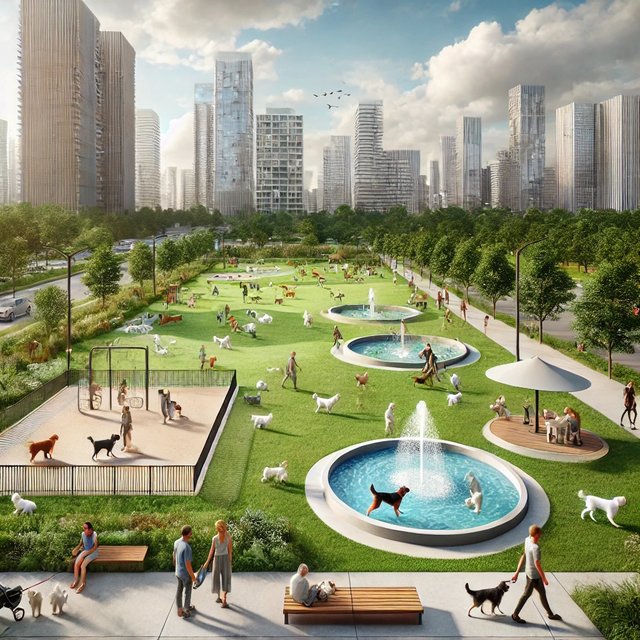Creating Safe Cities for Pets: How Civil Engineering Can Shape Urban Spaces

How Civil Engineering Can Shape Urban Spaces
We all love our pets. They’re integral parts of our families, yet many urban environments aren’t designed with pets in mind. Have you ever noticed how hard it can be to find a safe, open space for your dog to run freely in a crowded city? Many pet owners face this struggle. A recent study found that over 60% of urban households own pets, but cities often lack sufficient green spaces to accommodate them (American Pet Products Association, 2023). By building more green areas and pet-designated zones, civil engineers can create safer, more welcoming urban environments for both pets and their owners, fostering stronger, healthier communities.
Expanding Green Spaces for Pets
One of the most effective ways to make cities more pet-friendly is by increasing the number of green spaces. Think of the last time you walked through a busy park with your dog—was it relaxing, or were you constantly dodging crowds? Now imagine a park with open areas specifically for pets, complete with dog parks, pet-safe water features, and walking paths. These spaces allow pets to roam freely, exercise, and socialize, which is essential for their health. According to the Centers for Disease Control and Prevention (CDC), access to green spaces not only improves physical health but also reduces stress and anxiety for both pets and humans (CDC, 2022).
Cities like New York City and Tokyo have implemented dog-friendly spaces in parks, setting an example of what thoughtful urban planning can achieve. New York’s Central Park offers off-leash hours in several areas, and Tokyo’s Yoyogi Park has a large, fenced dog run. These kinds of spaces provide owners with a sense of security, knowing their pets are free to run and play without danger. In fact, studies show that exposure to green spaces increases physical activity and social interaction among pet owners (Frumkin et al., 2021).
Prioritizing Pet Safety in Urban Infrastructure
Safety is another key issue when designing pet-friendly cities. Streets, sidewalks, and transportation systems are often designed with people in mind, but what about the animals that live alongside us? A 2020 report from the American Society of Civil Engineers (ASCE) found that pedestrian and animal safety are often neglected in urban infrastructure, leading to an increase in accidents involving pets in urban areas (ASCE, 2020). As urban populations grow, the risk for pets only increases if safety isn’t addressed.
Engineers can solve this by implementing pet-safe crosswalks with signals designed for both pets and owners. In the Netherlands, some cities have already begun testing crosswalks with visual and sound cues tailored for pets. Additionally, installing barriers along busy roads can prevent pets from wandering into traffic. According to the American Veterinary Medical Association (AVMA), more than 1.2 million dogs are killed by vehicles annually, and simple safety measures could significantly reduce this number (AVMA, 2021). Pet-friendly public transportation options could also provide safer travel for pet owners. In San Francisco, for example, certain bus routes now offer designated areas for pets, making commuting with animals safer and more convenient.
A Call for Pet-Friendly Urban Planning
As communities grow, urban planners need to consider more than just human needs—they must create environments where pets can thrive too. According to World Animal Protection, a growing number of cities are recognizing the importance of integrating animal welfare into urban planning, with initiatives in cities like London and Melbourne setting global examples (World Animal Protection, 2022).
Making urban areas safer and more accessible for pets is more important than it may seem. By expanding green spaces and improving safety measures, civil engineers can ensure pets have safe, enjoyable environments to live in. Whether you're a pet owner advocating for more pet-friendly areas, or a civil engineering student inspired to make a difference, you have the power to shape urban spaces where both pets and people can flourish. Imagine a future where every walk with your dog is a peaceful journey through a park designed with your pet in mind. With thoughtful planning and advocacy, this future can become a reality in cities worldwide.
Works Cited
American Pet Products Association. "Pet Industry Market Size, Trends & Ownership Statistics." APPA, 2023, https://www.americanpetproducts.org/press_industrytrends.asp.
American Society of Civil Engineers. "2020 Report Card for America’s Infrastructure." ASCE, 2020, https://infrastructurereportcard.org/.
American Veterinary Medical Association. "Vehicle Accidents and Pets." AVMA, 2021, https://www.avma.org/resources-tools/pet-owners/petcare/vehicle-accidents-and-pets.
Centers for Disease Control and Prevention. "Parks and Green Space." CDC, 2022, https://www.cdc.gov/healthyplaces/parks_green_space.htm.
Frumkin, Howard, et al. "Nature Contact and Human Health: A Research Agenda." Environmental Health Perspectives, vol. 129, no. 7, 2021, https://ehp.niehs.nih.gov/doi/full/10.1289/EHP8513.
World Animal Protection. "Urban Planning and Animal Welfare: A Global Perspective." World Animal Protection, 2022, https://www.worldanimalprotection.org/news/urban-planning-animal-welfare.